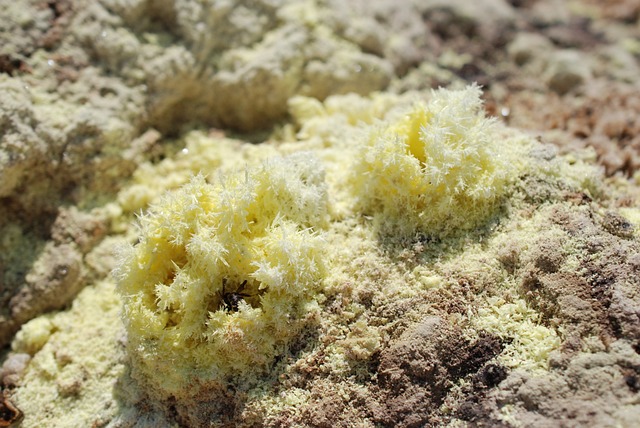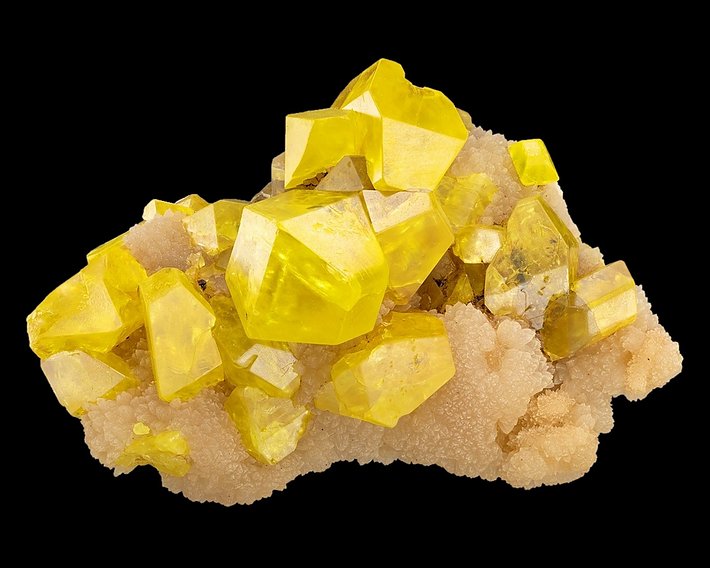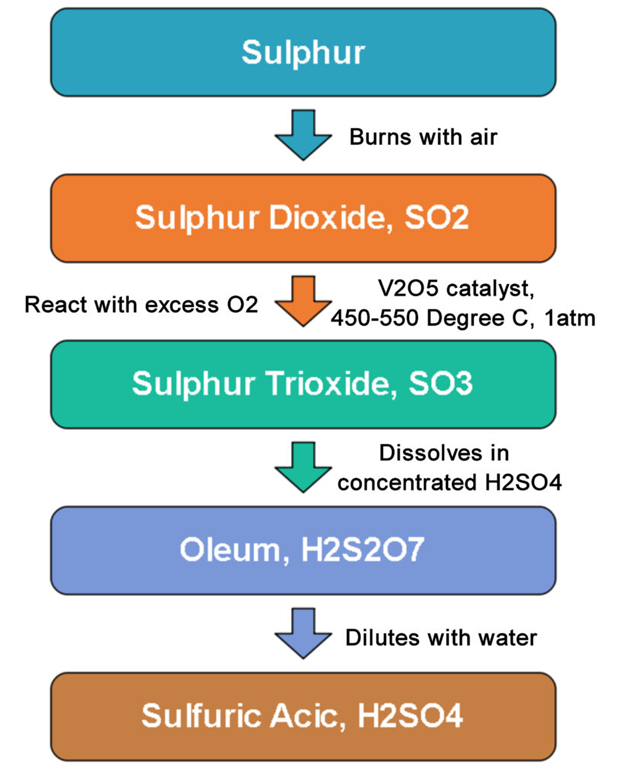What is Sulfur?

The group 6A elements are listed in the Table on the side here. This group of elements are intimately related to our lives. We need oxygen all the time throughout our lives. It is responsible for some of the protein structures in all living organisms. The metallic properties increase as the atomic number increases. The element polonium has no stable isotopes, and the isotope with mass number 209 has the longest half-life of 103 years.
Properties of oxygen are very different from other elements of the group, but they all have 2 electrons in the outer s orbital, and 4 electrons in the p orbitals, usually written as s2p4.
The trends of their properties in this group are interesting. Knowing the trend allows us to predict their reactions with other elements. Most trends are true for all groups of elements, and the group trends are due mostly to the size of the atoms and number of electrons per atom.
Current Trends
The metallic properties increase in the order oxygen, sulfur, selenium, tellurium, or polonium. Polonium is essentially a metal. It was discovered by M. Curie, who name it after her native country Poland. Electronegativity, ionization energy (or ionization potential IP), and electron affinity decrease for the group as atomic weight increases. The atomic radii and melting point increase. Oxygen differs from sulfur in chemical properties due to its small size. The differences between O and S are more than the differences between other members. Sulphur is a pale yellow, odorless, brittle solid, which is insoluble in water but soluble in carbon disulphide. Sulphur is essential to life. It is a minor constituent of fats, body fluids, and skeletal minerals.
In 1839, Charles Goodyear accidentally dropped a mixture of rubber and Sulphur into a fire. Goodyear called his rubber materials "vulcanized" after Vulcan the Roman god of fire.
In the 1800s, mothers in Britain often gave their children a spoonful of Sulphur and molasses as a spring tonic. Today, Sulfa drugs fight the bacteria that cause meningitis. Sulphur ointments treat skin infections.

Most of the sulfur that is produced is used in the manufacture of sulfuric acid (H2SO4). Large amounts of sulfuric acid, nearly 40 million tons, are used each year to make fertilizers, lead-acid batteries, and in many industrial processes. Smaller amounts of sulfur are used to vulcanize natural rubbers, as an insecticide (the Greek poet Homer mentioned "pest-averting Sulphur" nearly 2,800 years ago!), in the manufacture of gun powder and as a dying agent.
In addition to sulfuric acid, sulfur forms other interesting compounds. Hydrogen sulfide (H2S) is a gas that smells like rotten eggs. Sulfur dioxide (SO2), formed by burning sulfur in air, is used as a bleaching agent, solvent, disinfectant and as a refrigerant. When combined with water (H2O), sulfur dioxide forms sulfurous acid (H2SO3), a weak acid that is a major component of acid rain.
The element Sulphur is a non-metal and will not dissolve in water. The pure element Sulphur has very little smell. The smell you might associate with Sulphur bad eggs is actually a compound of Sulphur, the gas known as hydrogen sulfide. Sulphur compounds are also responsible for the smell in garlic, mustard, onions, and cabbage. A Sulphur compound even gives skunks their ferociously powerful and long-lasting smell. Indeed, Sulphur is a part of all living tissues. Sulphur is fixed into proteins in plants, and acquired by animals who eat the plant materials. The Greek name for Sulphur is 'Thion' - hence the product name: Shell Thiogro.
Properties of Sulfur?
Sulphur is a non-metallic chemical element identified by the letter S.It has the atomic number 16.Sulphur burns with a blue flame that emits sulphur dioxide, notable for its peculiar suffocating odour.
In its native form, it is a yellow crystalline solid. At room temperature, sulphur is a soft, bright-yellow solid. Sulphur is insoluble in water. Unlike most other liquids, the viscosity of sulphur in its molten state, increases above temperatures of 200°C due to the formation of polymers. Pure sulphur known as elemental sulphur is odourless.
Origination of Sulphur
Sulphur is the 16th most abundant element in nature. It is found in the earth's crust, in the ocean and even in meteorites. Sulphur occurs naturally all over the world and is most prolific where sulphur-rich gas and oil is processed and refined i.e. United States, Canada, the Former Soviet Union, and West Asia. Canada is the biggest exporter and China is the biggest importer of sulphur.
Uses of Sulphur

Sulphur is used in many textiles, rubber products such as tyres and boots, daily household products such as detergents, paints, paper and carpets. It is also used in many life-saving medicines.
Agriculture
Sulphur is one of the essential plant nutrients, along with nitrogen, phosphorus and
potassium. It can contribute to an increase in crop yields in three different ways:
It provides a direct nutritive value.
It provides indirect nutritive value as soil amendments, especially for calcareous and saline
alkali soils.
It improves the efficiency of other essential plant nutrients.
Sulphur is the primary source to produce sulphuric acid, the world's most used chemical and a versatile mineral acid used as an essential intermediate in many processes in the chemical and manufacturing industries.
IndustrySulphur is also used in many other industries including non-ferrous metals, pigments, fibres, hydrofluoric acid, carbon disulphide, pharmaceuticals, agricultural pesticides, personal care products, cosmetics, synthetic rubber vulcanization, water treatment, and steel pickling.
AsphaltSulphur asphalt (SA), sometimes referred to as sulphur bitumen, sulphur extended asphalt or SEA, is a viable alternative for asphalt road binder. Sulphur's unique properties to improve the characteristics of asphalt have been known for more than a century.
ConcreteSulphur concrete is a relatively new corrosion resistant material that contains stones, sand and sulphur polymer cement binder. Sulphur concrete is mixed and placed at a elevated temperature. It rapidly gains high strength over a few hours of cooling and provides an economic long-term performance in many harsh environments.
*Source - The Sulphur Institute
Recovered Sulfur from Oil or Gas
Recovered elemental sulfur, a nondiscretionary byproduct from petroleum refining, natural
gas processing, and cooking plants, was produced primarily to comply with environmental
regulations that were applicable directly to emissions from the processing facility or
indirectly by restricting the sulfur content of the fuels sold or used by the facility.

Lump Sulfur
Sulphur Lump is excessively required for a variety of applications in numerous industries such as Chemical industry. HPChemX is actively engaged in offering the finest quality Sulphur Lump to our clients. As we believe in offering the best, we leave no stone unturned to acquire Sulphur Lump from the most reliable Clients/Vendors only.
Specifications
| Property | Limits | Test Method |
|---|---|---|
| Physical Form | Lumps & Powder | Visual |
| Appearance | Bright Yellow | Visual |
| Purity on Dry Basis, wt% | 99.80% Min | ASTM D-4239 |
| Moisture, wt% | 0.02% Max | ASTM D-2790 |
| Ash Content, wt% | 0.015% Max | ASTM D-1509 |
| Organic Solid Matter, wt% | 0.01% Max | NA |
| Acid Content, wt% | 0.0001% Max | ASTM D-1613 |
| Mechanical Impurities(Paper, Wood, Sand, Etc), wt% | 0.01% Max | NA |
Granular Sulfur
Specifications
| Property | Limits | Test Method |
|---|---|---|
| Physical Form | Granular | Visual |
| Appearance | Bright Yellow | Visual |
| Purity on Dry Basis, wt% | 99.80% Min | ASTM D-4239 |
| Ash Content, wt% | 0.05% Max | ASTM D-1509 |
| Acidity, wt% | 0.02% Max | ASTM D-1613 |
| Moisture, wt% | 0.5% Max | ASTM D-2790 |
| Hydrocarbons, wt% | 0.05% Max | ASTM D-2360 |
| Organic Solid Matter, wt% | 0.01% Max | NA |
| Size Distribution | ||
| - Bigger than 4.75 mm, wt% | 5% Max | |
| - Between 2.4 and 4.4 mm, wt% | 75% Min | |
| - Smaller than 2 mm, wt% | 3% Max | |
| - Smaller than 1.19 mm, wt% | 2% Max | |
| - Smaller than 300 microns, wt% | 0.1% Max |
